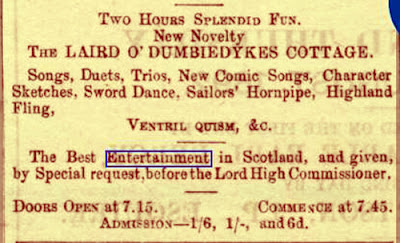My Theme
Family History Meets Local History -
Sources and Stories from England & Scotland
Our ancestors worked very long hours, but how did they enjoy themselves in their limited LEISURE TIME? You can best find out by searching local newspapers.
Reports abound in the local press covering my small village of Earlston in the Scottish Borders, whether leisure activities were sporting, cultural, educational, musical, dramatic, or just simply fun.
Earlston lies 32 miles south of Edinburgh, with its population numbers changing little over the period of 1861 (1749) to 2011 (1750). Yet in the late 19th century, villagers could enjoy a variety of events taking place in the Corn Exchange Hall. The adjacent Reading Room, founded in 1856 provided a quiet corner with its subscription library and billboard hall, but with strict rules that make entertaining reading today.

What could residents enjoy in the late 19th century?
- In Spring 1869 a series of "Penny Readings" were held with the comment that these were "instructive and pleasing entertainments."
- On
4th November 1869, "The Southern Reporter" described the formal
opening of a piano donated to the Corn Exchange by Mrs Colesworth of
Cowdenknowes.
The ceremony was slightly marred by an "unforeseen accident" in opening the piano, but this was followed by "three hearty cheers for Mrs Colesworth" and "a grand concert of miscellaneous music......with the hall crammed in every part."
- Also in November 1869, a meeting was called in the Corn Exchange for the Electors of Earlston to select a Liberal Candidate to stand in the forthcoming election, on the current MP Robertson being raised to the peerage. The handbill for the meeting carried the headline "Caution - Electors of Earlston - Beware!" with Lord William Hay selected to contend the seat.
- September 1869 saw the annual show of the Earlston Cottagers Horticultural Society taking place for the first time in the Corn Exchange. "The hall was set off in an artistic and pleasing manner" with contributions from the gardens and greenhouses of Cowdenknowes, Carolside and Drygrange - nearby estates.
-
On a more serious note, in January1869 a series of evangelical meetings was held "commencing the evening of Monday and continuing nightly until Sunday", when Lord Polwarth's talk was "listened to throughout his lengthy discourse with marked attention" from the packed hall".

- In December 1881 The Earlston Tradesmen held their annual "Show of Roots" in the Corn Exchange.
- In February 1884, a lecture entitled "Holidays in the Highland", was given by local bank manager John Mackenzie - one hopes he was a good speaker, as there would be no visual aids to enliven a long talk.
- A
concert and ball were held in September 1886 under the auspices of the
Earlston Street Lighting Committee to raise funds for winter street
lighting in the village.
"After the concert, dancing commenced to the inspiring strains of Earlston Orchestral Party and carried on with unabated zeal to the advanced hours in the morning.
 Earlston's Orchestral Party -one of the oldest photographs in the Auld Earlston collection.
Earlston's Orchestral Party -one of the oldest photographs in the Auld Earlston collection. - Another fund rising event in July 1889 was on behalf of the Bowling Club, founded six years earlier, who were looking to liquidate its debt, with"the amount taken far exceeded the sanguine expectation of the club." A wordy description gave a picture of the bazaar stalls - along with the more usual cushions and crafts, "live poultry" - and a painting by renowned Borders artist Tom Scott.
- In 1892, advertisements in "The Berwickshire News" promised the following entertainment at the Corn Exchange
- Taking to the stage on 17th September 1897 was "Alone in London - a wonderfully sensational and realistic Drama......the greatest ever put before a Scotch audience......witnessed on several occasion by Members of the Royal Family"
************
In the 20th century, villagers could enjoy regular dances -particularly popular in wartime, when the Polish Band (stationed in the village) provided the music; a major two day Masonic Bazaar, shows by the Girls' Club; regular whist drives, a cinema in the 1950s, follower by a short lived session of bingo nights. But the heydays of the Corn Exchange came to an end with a visit by pop star of the day Manfred Mann - a night still remembered by local folk. By the 1960s there were other forms of entertainment on offer i.e. television.
***********
Sources of Information
"The Berwickshire News" and "The Southern Reporter" on:
British Newspapers Online 1710-1963 at FindMyPast

British Newspapers Online 1710-1963 at FindMyPast







My ancestors were in the Horticultural Society and famous for their gladioli.
ReplyDeleteLoved Manfred Mann in the 60s ... Do wah diddy diddy dum diddy do"
It’s so times surprising the variety of entertainment available to our ancestors...certainly more than we have at the present moment. :)
ReplyDeleteExactly so, Pauleen. I was amazed to find how much was going on then in a small village.
ReplyDelete